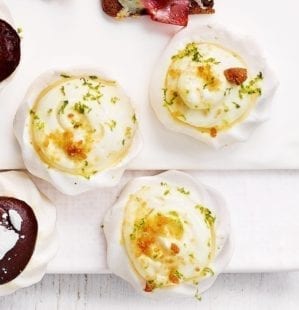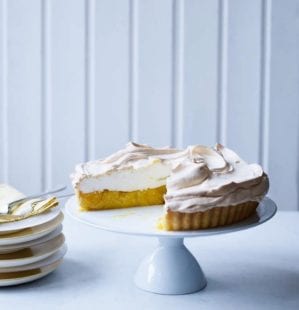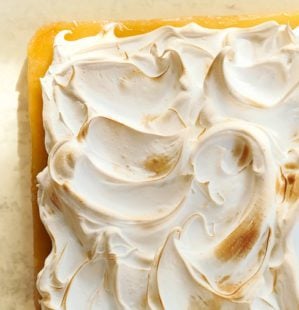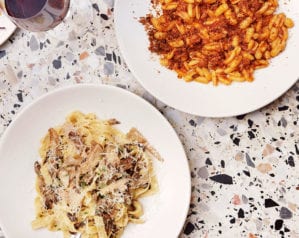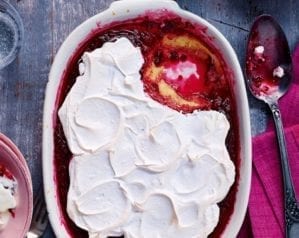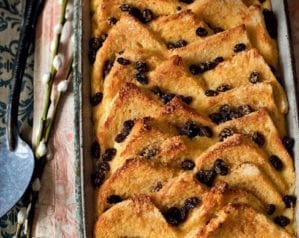
Gloria’s lemon meringue pie
- Published: 25 Aug 21
- Updated: 25 Mar 24
Learn how to make Gloria restaurant’s lemon meringue pie. The London restaurant’s famous pud has tangy custard, crumbly pastry and mile-high meringue.
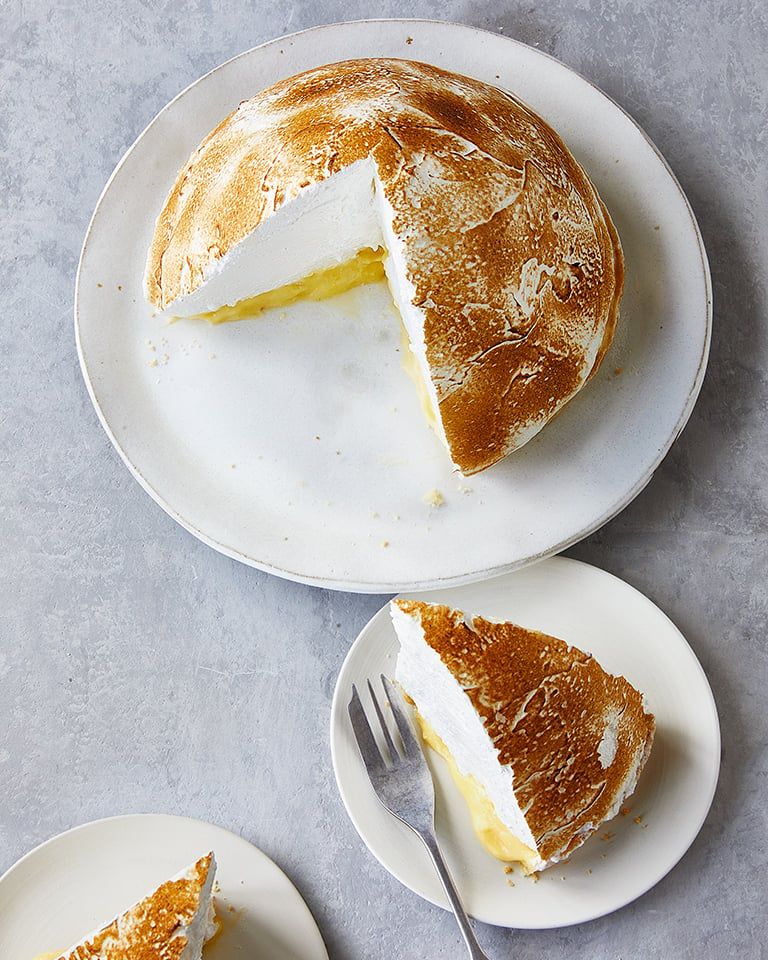
Fancy another technical bake from one of London’s best bakery-restaurants? Check out our recipe for Flor’s lardy buns.
-
Serves 8-10
-
Hands-on time 45 min, plus at least 8 hours chilling/resting
Ingredients
For the pastry
- 90g unsalted butter, softened
- 50g icing sugar
- 20g ground almonds
- 1 large free-range egg
- 150g plain flour, plus extra to dust
- ½ tsp salt
For the lemon custard
- 2 platinum-grade gelatine leaves – we used Dr Oetker
- 150g caster sugar
- Finely grated zest 2 unwaxed lemons, juice 3 lemons
- 3 large free-range eggs
- 210g cold unsalted butter, cut into 2cm cubes
For the Italian meringue
- 2 platinum-grade gelatine
- 230g caster sugar
- Juice 1 lemon
- 4 large free-range egg whites
You’ll also need
- Stand mixer with paddle and whisk attachments
- 22cm loose-bottomed tart tin, greased and the base lined with compostable baking paper
- Sugar thermometer or good digital thermometer
- Chef’s blow torch
Useful to have
- Stick blender or food processor
Method
- For the pastry, put the butter, icing sugar and ground almonds in a stand mixer fitted with a paddle attachment and beat until smooth. Add the egg and beat again until well combined. Sift in the flour and salt, then briefly mix on a low speed until the pastry just comes together. Form the dough into a ball, wrap well and put in the fridge to rest for at least 8 hours or overnight.
- For the lemon custard, put the gelatine in a bowl of cold water and set aside to soften for 5-10 minutes. Put the sugar and lemon juice in a pan over a medium heat and cook, stirring regularly, until the sugar dissolves. Bring to the boil, then remove from the heat.
- Put the 3 eggs in a large bowl and whisk until well combined. While whisking, slowly pour half the hot lemon mixture into the eggs (see Know How), then return the egg mixture to the saucepan and cook over a low heat, whisking constantly, until the mixture thickens and is gently boiling. Take off the heat. Squeeze the gelatine to remove excess water, then whisk into the lemon custard. Use a stick blender to gradually incorporate the butter into the hot custard (see Know How), then stir in the lemon zest. Pour the custard into an airtight container and chill for at least 8 hours or overnight (see Make Ahead).
- Once the pastry and lemon custard have chilled, heat the oven to 160ºC fan/gas 4. Roll out the pastry dough on a lightly floured surface into a large 25-26cm disc roughly 2-3mm thick. Line the tart tin, then use a sharp knife to trim the pastry flush with the edge of the tin (see Know How). Chill for 30 minutes, then line with compostable baking paper and fill with ceramic baking beans or uncooked rice. Bake for 15 minutes, then carefully remove the beans/rice and paper and return the pastry to the oven for 5-10 minutes more until the pastry base is cooked and dry to the touch. Set aside to cool.
- To make the meringue, put the sugar, lemon juice and 2 tbsp water in a heavy-based pan set over a low heat, stirring regularly until the sugar dissolves. Bring to the boil and cook until the mixture reads 120ºC on a cooking thermometer (see Know How). When the sugar syrup is almost at temperature (around 112ºC) whisk the egg whites to medium-stiff peaks in the very clean bowl of a stand mixer fitted with the whisk attachment (see Know How). With the mixer on medium, carefully pour the 120ºC syrup into the meringue in a thin stream (pour directly onto the egg white rather than the whisk or bowl). Continue to whisk until the meringue is thick and glossy and completely cooled.
- To assemble, briefly whisk the lemon custard to loosen it and remove any lumps, then spoon into the cooled pastry case. Pile the meringue on top and use a spatula to shape it into a tall dome. To get the authentic Gloria look, caramelise the outside of the meringue with a blow torch (or leave as is), then chill for an hour before serving.
- Recipe from August 2021 Issue
Nutrition
- Calories
- 480kcals
- Fat
- 26.6g (16g saturated)
- Protein
- 4.7g
- Carbohydrates
- 55.1g (43.5g sugars)
- Fibre
- 0.6g
- Salt
- 0.3g
delicious. tips
Watch how to make the lemon meringue pie here:
The pastry and the lemon custard can be made up to 2 days ahead and kept in the fridge. The meringue can be made 2-3 hours ahead and kept covered at room temperature. The tart is best eaten on the day it’s made.
The pastry Pâte sucrée is sometimes called sweet shortcrust, but the method is different. Butter and sugar are creamed with an egg before adding the dry ingredients, resulting in a more malleable dough. A long resting time is essential to allow the butter to firm up before rolling, and take your time when lining the tart shell – you may need to chill the pastry briefly between rolling and lining the tin.
The lemon custard The method for the custard is called tempering: a little of the hot mixture is added to the eggs to stop them scrambling when they’re added back into the pan. If you don’t have a stick blender, whizz the mixture in a food processor, adding the butter in a few additions.
The Italian meringue We recommend using a sugar thermometer (or digital thermometer) as the sugar syrup needs to be 120-122ºC when it’s mixed with the egg whites. The hot syrup cooks the whites, resulting in a soft, stable meringue that doesn’t need further cooking. Start whisking the whites just before the sugar syrup reaches the target temperature so they’re sufficiently whipped (they should be at medium peaks – the tips flop a little when the whisks are removed). Start whisking on a low-medium speed, then increase to medium. This helps to develop small, stable air bubbles in the egg white, resulting in a better texture.
Buy ingredients online
Rate & review
Rate
Reviews
Subscribe to our magazine
Food stories, skills and tested recipes, straight to your door... Enjoy 5 issues for just £5 with our special introductory offer.
Subscribe
Unleash your inner chef
Looking for inspiration? Receive the latest recipes with our newsletter

